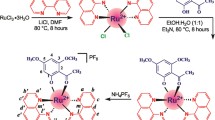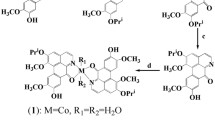Abstract
Rhodium (II) complex with 2-benzoylpyridine (Rh(L)2Cl2) is a new, synthetic, active metal-complex, which is produced by the reaction of 2-benzoylpyridine (L) with rhodium chloride hydrate (RhCl3·nH2O). The crystal structure was determined by X-ray diffraction which is mono-nuclear. In order to explore the biological properties of the novel complex, a series of studies were performed. The results showed that Rh(L)2Cl2 had the anti-tumor activity in HepG2 and other cell lines and has been shown to induce G1 cell cycle arrest and apoptosis in HepG2 cells. The anti-cancer effect of Rh(L)2Cl2 is regulated by increased expression of caspase-3 and PARP via the mitochondrial and the death receptor pathways. Bcl-2 family proteins might play an important role in the Rh(L)2Cl2-induced changes in these two pathways. Further studies indicated that Rh(L)2Cl2 increased the level of reactive oxygen species (ROS), but that Rh(L)2Cl2-induced apoptosis was ROS-independent. In conclusion, Rh(L)2Cl2 is a potential new anti-tumor drug, which induces HepG2 cell death via the mitochondrial and death receptor pathways and has no obvious toxicity to normal liver cell.







Similar content being viewed by others
Abbreviations
- L:
-
2-benzoylpyridine
- NAC:
-
N-acetyl-L-cysteine
- ROS:
-
Reactive oxygen species
- HCC:
-
Hepatocellular carcinoma
- ΔΨm:
-
Mitochondrial membrane potential
- JC-1:
-
5, 5, 6, 6′-tetrachloro-1, 1′, 3, 3′-tetraethylbenzimidazolylcarbocyanine
- MTT:
-
3-(4,5-dimethyl-2-thiazolyl)-2,5-diphenyl-2-H-tetrazolium bromide
- CDK:
-
Cyclin-dependent kinase
- DMSO:
-
Dimethyl sulfoxide
- NMR:
-
Nuclear magnetic resonance pectroscopy
- MS:
-
Mass spectroscopy
References
Anthony PP (2001) Hepatocellular carcinoma: an overview. Histopathology 35:109–118
Boonstra J, Post JA (2004) Molecular events associated with reactive oxygen species and cell cycle progression in mammalian cells. Gene 337:1–13
Bruijnincx PC, Sadler PJ (2008) New trends for metal complexes with anticancer activity. Curr Opin Chem Biol 12(2):197–206
Bruno Dipasquale AMMRJY (1991) Apotosis and DNA degradation induced by 1-methyl-4-phenylpyridinium in neurous. Biochem Biophys Res Commun 181(3):1442–1448
Chellan P, Land KM, Shokar A, Au A, An SH, Taylor D, Smith PJ, Riedel T, Dyson PJ, Chibale K, Smith GS (2014) Synthesis and evaluation of new polynuclear organometallic Ru(II), Rh(III) and Ir(III) pyridyl ester complexes as in vitro antiparasitic and antitumor agents. Dalton Trans 43(2):513–526
Chen ZF, Qin QP, Qin JL, Liu YC, Huang KB, Li YL, Meng T, Zhang GH, Peng Y, Luo XJ, Liang H (2015) Stabilization of G-quadruplex DNA, inhibition of telomerase activity, and tumor cell apoptosis by organoplatinum(II) complexes with oxoisoaporphine. J Med Chem 58(5):2159–2179
Chen W, Zheng R, Baad PDE, Zhang S, Zeng H, Bray F, Jemal A, Yu XQ, He J (2016) Cancer statistics in China, 2015. CA Cancer J Clin 66(2):115–132
Cuconati A, Mills C, Goddard C, Zhang X, Yu W, Guo H, Xu X, Block TM (2013) Suppression of AKT anti-apoptotic signaling by a novel drug candidate results in growth arrest and apoptosis of hepatocellular carcinoma cells. PLoS ONE 8(1):e54595
Desagher S, Martinou JC (2000) Mitochondria as the central control point of apoptosis. Cell Biol 10:369–377
Fulda S, Debatin KM (2006) Extrinsic versus intrinsic apoptosis pathways in anticancer chemotherapy. Oncogene 25(34):4798–4811
Gras M, Therrien B, Süss-Fink G, Casini A, Edafe F, Dyson PJ (2010) Anticancer activity of new organo-ruthenium, rhodium and iridium complexes containing the 2-(pyridine-2-yl) thiazole N,N-chelating ligand. J Organomet Chem 695(8):1119–1125
Gupta G, Garci A, Murray BS, Dyson PJ, Fabre G, Trouillas P, Giannini F, Furrer J, Süss-Fink G, Therrien B (2013) Synthesis, molecular structure, computational study and in vitro anticancer activity of dinuclear thiolato-bridged pentamethylcyclopentadienyl Rh(iii) and Ir(iii) complexes. Dalton Trans 42(43):15457
Hasnain SE, Begum R, Ramaiah KV, Sahdev S, Shajil EM, Taneja TK, Mohan M, Athar M, Sah NK (2003) Host-pathogen interactions during apoptosis. J Biosci 28(3):349–358
Huang GJ, Deng JS, Huang SS, Hu ML (2011) Hispolon induces apoptosis and cell cycle arrest of human hepatocellular carcinoma Hep3B cells by modulating ERK phosphorylation. J Agric Food Chem 59(13):7104–7113
Katsaros N, Anagnostopoulou A (2002) Rhodium and its compounds as potential agents in cancer treatment. Oncology/Hematology 42:297–308
Kaufmann SH, Earnshaw WC (2000) Induction of apoptosis by cancer chemotherapy. Exp Cell Res 256(1):42–49
Lavrik IN, Golks A, Baumann S, Krammer PH (2006) Caspase-2 is activated at the CD95 death-inducing signaling complex in the course of CD95-induced apoptosis. Blood 108(2):559–565
Li GQ, Chen XG, Wu XP, Xie JD, Liang YJ, Zhao XQ, Chen WQ, Fu LW (2012) Effect of dicycloplatin, a novel platinum chemotherapeutical drug, on inhibiting cell growth and inducing cell apoptosis. PLoS ONE 7(11):e48994
Li XJ, Zheng K, Wang LD, Li YT, Wu YZ, Yan CW (2013) Syntheses and crystal structures of tetracopper(II) complexes bridged by asymmetric N, N’-bis(substituted)oxamides: molecular docking, DNA-binding and in vitro anticancer activity. J Inorg Biochem 128:97–107
Li YL, Qin QP, Liu YC, Chen ZF, Liang H (2014) A platinum(II) complex of liriodenine from traditional Chinese medicine (TCM): cell cycle arrest, cell apoptosis induction and telomerase inhibition activity via G-quadruplex DNA stabilization. J Inorg Biochem 137:12–21
Lvctk BR (1965) Inhibition of cell division in escherichia coli by electrolysis products from a platinum electrode. Nature 205:698–699
Massagué J (2004) G1 cell-cycle control and cancer. Nature 432:298–306
Pae HO, Choi BM, Seo EA, Oh H, Shin MK, Kim TH, Kwon HTCTO (2002) Induction of apoptosis by 4-acetyl-12,13-epoxyl-9-trichothecene 3,15-diol from Isaria japonica Yasuda through intracellular reactiveoxygen species formation and caspase-3 activation in humanleukemia HL-60 cells. Toxicol In Vitro 17:49–57
Solange D, Astrid OS, Anthony N, Robert E, Sylvie M, Sandra L, Kinsey M, Bruno A, Jean-Claude M (1999) Bid-induced conformational change of Bax is responsible for mitochondrial cytochrome c release during apoptosis. Cell Biol 144(5):891–901
Tamm I, Wang Y, Sausvile ED, Scudiere DA, Vigna N, Oltersdorf T, Reed JC (1998) IAP-family protein survivin inhibits caspase activity and apoptosis induced by Fas (CD95), Bax, caspases, and anticancer drugs1. Can Res 58:5315–5320
Torre LA, Bray F, Siegel RL, Ferlay J, Lortet-Tieulent J, Jemal A (2015) Global cancer statistics, 2012. CA Cancer J Clin 65(2):87–108
Vousden GIEKH (2001) Proliferation, cell cycle and apoptosis in cancer. Nature 411:342–348
Yang BF, Xiao C, Li H, Yang SJ (2007) Resistance to Fas-mediated apoptosis in malignant tumours is rescued by KN-93 and cisplatin via downregulation of c-FLIP expression and phosphorylation. Clin Exp Pharmacol Physiol 34(12):1245–1251
Zhang R, Humphreys I, Sahu RP, Shi Y, Srivastava SK (2008) In vitro and in vivo induction of apoptosis by capsaicin in pancreatic cancer cells is mediated through ROS generation and mitochondrial death pathway. Apoptosis 13(12):1465–1478
Acknowledgements
The present study was supported in part by the National Natural Science Foundation of China (No. 8156130230) and the Natural Science Foundation of Guangxi (2015GXNSFEA139003).
Author information
Authors and Affiliations
Corresponding authors
Ethics declarations
Conflict of interest
The authors declare that there are no conflicts of interest.
Electronic supplementary material
Below is the link to the electronic supplementary material.
10534_2017_56_MOESM1_ESM.docx
Supplementary information included the elemental analysis of Rh(L)2Cl2 and the IC50 Value of compounds, the IR (KBr) spectra, the 1HNMR (600 MHz, DMSO-d6) of Rh(L)2Cl2, the cell cycle of HepG2 treated with Rh(L)2Cl2 and L. Supplementary material 1 (DOCX 200 kb)
Rights and permissions
About this article
Cite this article
Wang, X., Li, Y., Lin, M. et al. Rhodium (II) complex with 2-benzoylpyridine, a novel potential chemotherapeutic drug, induces cell cycle arrest and apoptosis in HepG2 cells. Biometals 30, 903–915 (2017). https://doi.org/10.1007/s10534-017-0056-4
Received:
Accepted:
Published:
Issue Date:
DOI: https://doi.org/10.1007/s10534-017-0056-4




